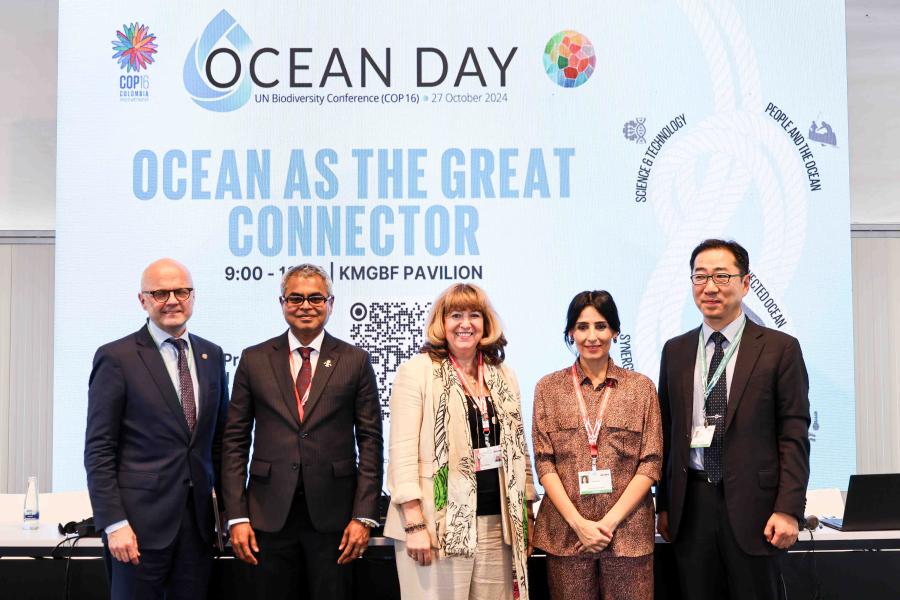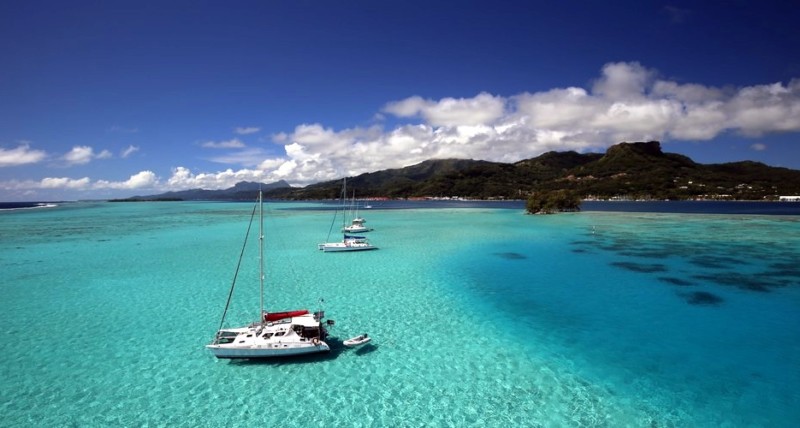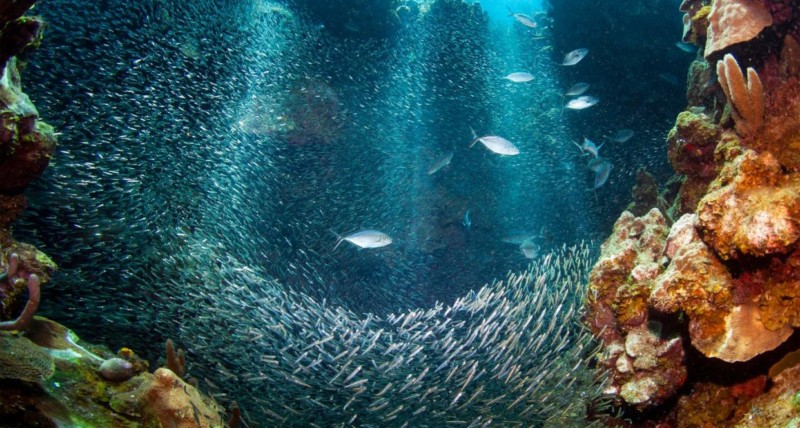The Ocean is the Great Connector—linking peoples, cultures, economies, and ecosystems. The Kunming-Montreal Global Biodiversity Framework (GBF) recognizes this connection, with nearly all targets containing a link to the Ocean. Ocean Day at COP 16 celebrated those relationships, uniting global actors from diverse fields, working to advance ocean conservation, research, and sustainable use. Ocean Day featured engaging, interactive events, with audience polls, videos and musical interludes, talk-show formats, and theater, designed to inspire action to accelerate efforts on implementing the GBF.
High-Level Opening Session
Welcoming attendees, Joseph Appiott, Convention on Biological Diversity (CBD) Secretariat, hope that Ocean day would be one of exchange, dialogue, and inspiration.
Astrid Schomaker, Executive Secretary, CBD, noted that the Ocean permeates all GBF targets and should be fully integrated into work under the Framework. She called for looking beyond the “30×30” target to include issues such as mainstreaming and relationships with freshwater and land use.
Inger Andersen, Executive Director, UN Environment Programme (UNEP), said the Ocean injects vitality into the lives of people. She noted that Sustainable Development Goal (SDG) 14 (life below water) is one of the least financed goals and said without finance and policy shifts, there cannot be real action.
Thoriq Ibrahim, Minister of Climate Change, Environment and Energy, Maldives, noted his country has taken bold action to protect 14% of coral reefs, with more areas slated for protection by 2030. He said halting and reversing environmental harm is essential, not just for the Maldives, but for the entire world.
Peter Thomson, UN Secretary-General’s Special Envoy for the Ocean, called for a clear plan on the 30×30 target. He shared the example of the Azores, which has established the largest marine protected area (MPA) in Europe, with half of its area designated as a no-take zone. He said sustainable use and conservation is not an “arm wrestle” that needs to be won; rather, the priority is maintaining the tension and balance between them.
Razan Al Mubarak, President, International Union for Conservation of Nature (IUCN), highlighted positive action and initiatives, including: the High Level Panel for a Sustainable Ocean Economy; ocean breakthroughs under the Marrakech Partnership for Global Climate Action and the UN Framework Convention on Climate Change (UNFCCC) umbrella; a whole-of-society approach; efforts to realize the nexus between Nationally Determined Contributions (NDCs), National Biodiversity Strategies and Action Plans (NBSAPs); and engagement with Indigenous Peoples and local communities (IPLCs).
Jae Young Shin, Ministry of Oceans and Fisheries, Republic of Korea, emphasized continuing to promote collective efforts toward the conservation and sustainable use of marine resources. He said the Republic of Korea was honored to host the upcoming 10th Our Ocean conference in Busan, Republic of Korea, under the theme “Our Ocean, Our Action,” in April 2025.
Vidar Helgesen, Executive Secretary, Intergovernmental Oceanographic Commission (IOC) of the UN Educational, Scientific and Cultural Organisation (UNESCO), outlined gaps in knowledge about the Ocean, and noted progress on: frameworks for action; monitoring and reporting; and assessments for integrating data into national reports. He announced the publication.
People and the Ocean: Fishers as Stewards of Biodiversity
This session focused on the perspectives of fishers about their roles as users of and contributors to marine biodiversity.
Kim Friedman, Food and Agriculture Organisation of the UN (FAO), moderated the panel.
In opening remarks, Universe Yamase Lawrence, Deputy Permanent Representative of the Permanent Mission of the Federated States of Micronesia to the UN, reminded attendees that people are part of, not apart from, the rest of nature and that people are stewards of biodiversity.
Zoila Bustamante Cardenas, Latin American Union of Artisanal Fisheries and of the Confederation National Association of Artisanal Fishermen of Chile (CONAPACH), underscored the importance of fishers to be represented in discussions relating to the Ocean, saying they are the ones most connected to it.
Javier Garat, International Coalition of Fishing Associations (ICFA), said the fishing sector is rarely consulted on matters related to the environment, called for more coordinated efforts, and said fishers are part of the solution to ocean-related challenges.
Sefanaia Nawadra, Secretariat of the Pacific Regional Environment Programme (SPREP), said practices in coastal fisheries, which include involvement of customary practices and traditional knowledge, should be translated to oceanic fisheries to better manage and integrate nature with the work that needs to be done.
In the question-and-answer session, topics included: the ways fishers are impacted by other ocean-related developments, such as petroleum; plastic pollution; bycatch; and bringing fishers to the center of marine biodiversity conservation.
The Connected Ocean
David Johnson, Global Ocean Biodiversity Initiative (GOBI), introduced the session using the concept of the Ocean as home, and took participants on a journey of what was found in each of the rooms:
- Attic: Whales connect the Ocean, but are subject to threats from bycatch, entanglement, and pollution, and the role of the International Whaling Commission (IWC) in protecting them;
- Bedroom: Albatrosses and other migratory birds, and the importance of their role in the design of ecologically representative and well-connected MPAs, through tools such as the Migratory Connectivity in the Ocean (MICO);
- Bathroom: The ocean sunfish, enjoying the clean surroundings, including the particularly sensitive sea area declared by the International Maritime Organization (IMO);
- Hallway: The blue whale, asking to ensure that whale superhighways are free from plastic pollution, oil, and gas infrastructure, and other elements that may block ocean connectivity;
- Kitchen: Migratory species identified under the Convention on Migratory Species (CMS), and their need for a network of habitats for breeding and feeding;
- TV room: Seamounts in areas beyond national jurisdiction (ABNJ), and their vertical and horizontal connectivity in the Ocean, pointed out by IUCN;
- Sitting room: The Pacific family, represented by SPREP, and their role as caretakers of the Pacific Ocean;
- Conservatory: A poem by the Global Island Partnership (GLISPA), with a call to strengthen partnerships to protect and nurture the legacy of our seas; and
- Basement: Hydrothermal vents, and how they are addressed by the Biodiversity Beyond National Jurisdiction (BBNJ) Agreement.
During the lunch break participants enjoyed a musical performance by local musical group Monsieur Periné, with a series of videos showing in the background on whales, mangroves, Antarctic expeditions, and other ocean topics.
The Great Ocean-Climate Talk Show: Power the Ocean Breakthrough
This first afternoon session explored ocean-based climate and biodiversity solutions, using a pitch-your-ideas-contest format. Loreley Picourt, Ocean & Climate Platform, opened the session
Pauli Merriman, World Wild Fund for Nature (WWF), moderated the panel, where each speaker pitched their breakthrough concept, explaining how it can deliver on GBF targets and climate goals. Their pitch topics were based on five key ocean sectors outlined in the Ocean Breakthroughs initiative.
On marine conservation, Ignace Beguin Billecocq, Ocean Lead, Climate Champions Team, focused on the three key coastal ecosystems—mangrove, corals, and seagrass—as a way to specifically measure the impact of restoring and protecting ecosystems in coastal communities. He said being ecosystem-specific enables tangible and concrete solutions.
On aquatic food, Annie Mark, Environmental Defense Fund, said mentioned two main solutions: incorporating aquatic food into national biodiversity and climate plans, and moving toward implementation, including funding. She said the goal is sustainable management across 100% of the fisheries.
On offshore wind, Rennie Meyer, Ørsted, said net-positive biodiversity outcomes are possible if there is a holistic commitment and mobilization of finances. She highlighted the importance of access to data, including considering what is the right data to share.
On shipping, Simon Chin-Yee, University College London, noted that the IMO has published the Strategy on Reduction of GHG Emissions from Ships. He said connectivity and collaboration between countries and ports should be strengthened, and that trust should be built with the shipping industry.
On coastal tourism, Victor Galvan, Iberostar Group, said over 50% of those who travel do so to connect with nature. He underscored the importance of investment to build resilience and protect ecosystems, including nature-based solutions and working at the community level.
Picourt invited comments by three audience participants, who highlighted: the CMS 2030 Seagrass Breakthrough as a roadmap; sustainable ocean plans for leveraging the Ocean Breakthroughs for effective national strategies; and the Great Blue Wall initiative on regeneration, and Regenerative Ocean Week in February 2025.
Picourt closed the session, noting conclusions that are relevant for UNFCCC COP 29, namely ocean finance is climate finance, and momentum should be built for blue NDCs.
Science & Technology For Action
Susan Gardner, UNEP, gave the keynote address on the importance of science and technology for GBF implementation. She stressed access to information, involving local communities for solutions, and described a UNEP project using an artificial intelligence (AI)-powered platform that allowed forecasting plastic pollution nine months out. There were two segments under this topic.
Connecting across the ocean science value chain to support GBF implementation
Alison Clausen, IOC/UNESCO, moderated the first segment on this issue.
On the role of observations to support the GBF, Sophie Seeyave, Partnership for Observations of the Global Ocean (POGO), said sustained biological observations are critical, including for monitoring and managing invasive species.
On the role of data to support the GBF, Paula Sierra Correa, INVEMAR, identified the need for timely dissemination of quality data; ensuring that data are easily discovered and accessible; and for capacity building between collectors and decision makers.
On connecting science and knowledge to policy and decision makers, Gideon Henderson, Department of Environment, Food and Rural Affairs, UK, made the following recommendations: be neutral, transparent, and open to criticism; include uncertainty and caveats; consider scale; be aware of the context and mindful of people and place; ensure communications are solution-focused; and know who is receiving the advice.
From the Real World: Success Stories of the Use of Science and Knowledge to GBF Implementation
On the second segment, David Obura, CORDIO East Africa, gave an example of working with fishing communities to consider the impact of mesh sizes, which resulted in a greater fish catch and lower biodiversity impacts.
Cesar Penaherrera, MigraMar, shared that analysis of multi-year data from shark tagging resulted in an expanded regional protected area with greater connectivity.
David Barrios, MarViva, described a participatory monitoring project where community management helped extend an exclusive fishing zone.
During closing, Jose Dallo, International Seabed Authority (ISA), outlined information sources related to the deep sea and its contribution to other frameworks.
Juan Camilo Ferrero, Executive Secretary, Colombian Ocean Commission, and Vice Chair IOC/UNESCO, said the Decade of Ocean Science was helping transform our understanding of the Ocean, and called for continued contributions.
Synergies & Partnerships For Impact: Uniting for the Ocean: Accelerating Action for Biodiversity Goals
Silvia Guzzini, World Economic Forum (WEF) and Puri Canals, Global Network of MPA Networks, opened the session.
Synergies with Other International Agreements and Frameworks
Charlotte Salpin, UN Division for Ocean Affairs and the Law of the Sea, moderated.
Joseph Appiott, CBD Secretariat, described the role of the Sustainable Ocean Initiative Global Dialogue with regional seas organizations and regional fishery bodies and said it is crucial to make use of available mechanisms and processes to bring about synergies in achieving global targets.
On the importance of high seas for GBF targets, Rebecca Hubbard, High Seas Alliance, emphasized their role in achieving Targets 3, 4, 8 and 10 of the GBF. She said ecologically or biologically significant marine areas (EBSAs) can be useful to the scientific underpinning for future MPAs and environmental impact assessments in the high seas.
Siri Bjune, UN Office on Drugs and Crime (UNODC), explained that enhanced maritime law enforcement can support GBF implementation. She said strengthening monitoring, surveillance and compliance in the Ocean is key to protecting biodiversity.
Remi Parmentier, Let’s be Nice to the Ocean initiative, underscored the role of civil society in uniting the Ocean. He shared their new publication, Advancing the Ocean Principle, which recognizes the linkages between the GBF and the protection principle.
National, Regional and Global Perspective: How to Work More Efficiently Across Levels with Practitioners and Civil Society
Puri Canals moderated this panel.
Cynthia Barzuna, World Resources Institute, presented the work of Ocean Action 2030, which provides support to countries in developing sustainable ocean plans. She also described technical and financial assistance to coastal and ocean countries to deliver on ambitious commitments by 2030.
Per Fredrik Pharo, Norwegian Agency for Development Cooperation, explained how the EAF-Nansen Programme enhanced partnerships and synergies with other countries, including through capacity building that provided assistance for young scientists. He said connecting national actions to regional collaboration is a catalyst for global change.
Carole Martinez, MedPAN, provided the Global Network of MPA Manager Networks as an example of linking regional and national institutions to the international level. She said the network of MPA managers cooperate to support the GBF through sharing information, knowledge and tools; building network capacity; policy support and advocacy; and financing.
Francis Staub, International Coral Reef Initiative (ICRI), lamented the current state of coral reefs. He said that even though ICRI is an informal partnership, it is unique because its documents are acknowledged within the UN system and it provides guidance on how to integrate coral reefs into NBSAPs.
Public-Private-Philanthropic Partnerships
Alfredo Giron, WEF, introduced this session.
Arnoldo André Tinoco, Minister of Foreign Affairs and Worship, Costa Rica, said the loss of biodiversity cannot be solved in isolation. He described a collaborative public-private project to create an “ocean account” for mangrove restoration that allows them to measure changes in the ecosystem, including the flow of ecosystems services.
Fireside Chat: Private Sector Action
Benj Sykes, Ørsted, described a net-positive biodiversity impact in offshore wind farm projects, and restoration of native oysters and seagrass in a degraded part of the UK.
Juliana Suso, Interconexion Electrica SA ESP, described work in Latin America related to voluntary carbon credits, and exploring possible approaches to the blue carbon market.
Camille Maclet, BNP/Paribas, said her company is collaborating on identifying drivers that lead to biodiversity loss in the Ocean, which is guiding how they engage with clients.
Comments by panelists on how the private sector could accelerate contributions to the GBF included, among others reducing consumption, and synthesizing and integrating work on climate and biodiversity.
Innovative Finance Solutions—a successful example
Pradeep Kurukulasuriya, Executive Secretary, UN Capital Development Fund, said the Global Fund for Coral Reefs is helping close the finance gap. He emphasized the need to focus on small businesses, and being willing to invest in businesses that traditional funders would consider too risky.
Carla Lumba, COP 16 Youth Representative, said we are not here just to exchange ideas, but to chart the course forward, noting the dire conditions many youth face today. She called on leaders and policymakers to accelerate action and for bold commitments at high-level meetings.
Crafting a Better Future
The Global Youth Biodiversity Network (GYBN) led the closing session of Ocean Day by asking attendees to reflect on their connection to the Ocean. They expressed with words and interpretative motion the story of the Ocean, once teeming with life, but now neglected. They shared the Youth Priorities on Ocean Conservation, reached in consultation within their network, including Indigenous Peoples, and passed it on symbolically to Minister Tinoco.
In closing remarks, Tinoco looked forward to the Third UN Ocean Conference in June 2025 in Nice, Frank, and invited attendees to actively participate in this upcoming milestone. He said that new, action-oriented commitments are needed to heed the call of the Ocean for safeguarding and protection.
Olivier Poivre d’Arvor, Ambassador for the Poles and Maritime Issues, France, reiterated that the Third UN Ocean Conference will be a defining moment for the ocean community, and expressed his hope that the momentum built on Ocean Day in Cali, Colombia, would be seamlessly continued and brought forward to Nice, France.
Source: iisd




